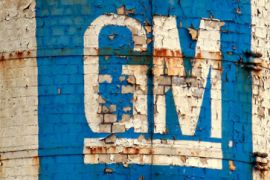Deconstructing General Motors
Al Jazeera explains the vehicle manufacturer’s problems.

 |
| For seven decades Detroit-based GM has stood as a towering icon of American capitalism [AFP] |
General Motors’ decision to file for bankruptcy protection is a huge deal in the business history of the US and possibly the globe.
For 70 years GM was the world’s largest vehicle maker. It only lost that crown to Toyota in 2008.
| In depth |
|
|
GM was one of a handful of North American firms that busted out of the country’s borders to help create what we now think of as “the American Century”.
Keep reading
list of 4 itemsRussia’s Putin eyes greater support from China for Ukraine war effort
India-Iran port deal: A gateway to Central Asia or a geostrategic headache?
India’s income inequality widens, should wealth be redistributed?
GM changed the planet – for good of bad, depending on your point of view.
Its Chapter 11 filing is the third largest behind the telecoms giant WorldCom and investment bank Lehman Brothers, whose collapse marked the start of the current financial meltdown in September last year.
General Motors is to be carved up into two new companies.
“New GM” will contain all the “good” bits of the old firm such as money making car plants and popular brands like Chevrolet, Cadillac, GMC and Buick; while “Old GM” will have all the “bad” assets like the run-down car plants and brands like Pontiac, Hummer and Saturn.
The US government is pumping in another $30.1bn and will take a 60 per cent equity stake.
Calling time
On a conference call with journalists late on Sunday evening the White House was at pains to point out that this will be the last public money GM ever sees. The restructuring either works or that’s it.
A spokesman for the Obama administration said the bankruptcy proceedings are expected to take between 60 and 90 days.
In many respects GM’s filing is not really news at all – it has been coming for months.
Last Friday a trader on the floor of the New York Stock Exchange joked that a reporter like me could “mail the story in”. He meant, of course, that it is all so predictable.
The trader in question stopped trading GM shares long ago, well before their closing value of less than a dollar.
Now, however, he is wondering who will replace GM in the top 30 countdown of famous companies known as the Dow Jones Industrial Average? He has several companies in mind – Cisco Systems, Apple, Google, Oracle, Monsanto, Wells Fargo and Goldman Sachs.
Incidentally, GM will now be the first Dow component to lose its place in the “Hot 30” because of bankruptcy in more than three decades.
 |
| Opel look likely to stay out of bankruptcy proceedings after Magna’s acquisition [AFP] |
If anyone is wondering what will happen to GM’s operations around the world, the White House was very clear.
There will be no US taxpayer dollars used to prop-up GM’s vast overseas network.
A journalist listening to the same briefing as me asked about GM’s Australia arm and was told to look at GM Europe for how things should be done.
GM Europe, maker of brands like Vauxhall in the UK and Opel in Germany, will most likely stay out of the bankruptcy proceedings because on Friday the Canadian car parts maker Magna agreed to buy GM Europe with the help of the German government.
Magna is backed by Russian money and has ambitions to expand into Russia.
It is still likely to lay-off thousands of workers but probably far fewer than Fiat would have done if it had won the bidding.
Buying time
Back on home turf in New York and Detroit, what happens now to GM?
President Obama will give full details in public at 1400GMT on June 1.
Chapter 11 Bankruptcy Protection is a device used by American business to reorganise themselves when things go badly wrong.
It buys them time, but is hugely embarrassing for the management team who look like complete failures.
A judge runs the company on a day-to-day basis making decisions on how every penny is spent.
For the time being GM plants will go on making vehicles and workers will turn up for work to knock them out and be paid for it.
Though clearly, a lot of pain must be expected among the workforce quite soon.
| GM’s debt |
|
$27bn in unsecured debt |
Chapter 11 requires a firm to have a restructuring plan and GM’s almost came undone last week.
The company’s bond holders rejected the firm’s first restructuring plan, walking away from an offer that would have given them a 10 per cent stake in the New GM in exchange for interest payments on the $27bn they have already sunk into the company.
Later an ad-hoc group of bond holders agreed to accept a reworked deal that would eventually give them roughly 25 per cent of the new firm.
However, the White House says only 54 per cent of bond holders agreed to the new deal by a deadline of May 30 at 2100GMT and the rest may decide to fight for their cash through the courts, which could slow the bankruptcy proceedings down a bit.
The White House declared itself pleased with the percentage of bond holders that are board.
All creditors will have their say when the bankruptcy court convenes a special committee to look into all aspects of GM’s debt probably by the end of the month.
Role model
Of course GM is not the only US car firm in bankruptcy protection right now. Its rival Chrsyler, the third-largest US vehicle maker, is also being run by a judge.
Cynics would tell you that Chrysler’s bankruptcy filing was designed to be a role model for the much larger GM filing.
It certainly looks as if things have been going pretty well for Chrysler with its sale to Fiat of Italy likely to be approved by a judge in New York on Monday.
If you think the timing of all this is a little suspicious, it almost certainly is.
One contact of mine told me, “There are powerful people at work behind the scenes to make sure all this gets done.”


